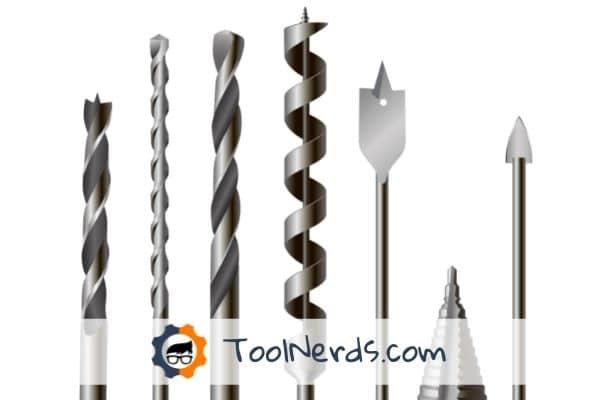
Without a bit, your hammer, pillar, or rotary drill is useless — you need to have a grasp of the different types of drill bits.
These robust boring heads are designed with particular applications, drill formats, and base materials in mind. Use one of the wrong drill bit types, and you may snap your bit, damage your target medium, or even wreck your power tool.
Consider this article to be your ultimate drill bit encyclopedia — providing an in-depth and clear description of the different types of drill bits and their uses.
Ready to become an amateur bit-boffin? Let’s get started!
The Ultimate Drill Bit Guide
Drills are manufactured with particular projects in mind — and so are their bits. Just as you select a hammer drill for masonry or a mag drill for steel — you choose different kinds of drill bits for specific jobs.
Particular boring heads can tackle an absolute plethora of mediums, including timber, plastic, metal, brickwork, glass, and ceramic.
The Design of Drill Bits Explained
Before we get down to the detail of different drill bit types and their applications — it’s crucial to get an initial grasp of three shared characteristics and how they vary across bit formats.
Diameter
Whatever types of drill bits you purchase, they will always be described in terms of the bit diameter — for example, 0.5-inch masonry or 0.375-inch spade. When selecting your drill head types, always check this important dimension.
The size you require naturally depends on your project — for channeling wiring beneath floorboards, you’ll need a large diameter bit, for driving one-sixteenth-inch screws into timber, you need a smaller driving head.
Shank and Chuck
Considering what drill bit to use initially requires you to check out the shank of the boring head and the chuck of your drill.
The shank is the non-threaded section behind the bit’s cutting edges — it fits into the chuck of your drill, the rounded tip at the head of your power tool that secures the bit through either a keyless ratcheting mechanism or specific chuck key.
These are not cross-compatible! Using the wrong format is akin to filling a gasoline car with diesel — but with an increased risk of having a sharp, fast-spinning metal rod flying into your eye.
Typically (although there are industrial-grade exceptions), bits are separated into three drill bit shank types:
- Rounded — standard bits that can be used with most keyed and keyless chucks of drill drivers, hammer drills, and right-angle drills.
- Hex — usually used on impact drills with a 0.25-inch hexagonal chuck.
- SDS — stands for Slotted Drive System, a bit with ‘wings’ that can only work with SDS or SDS+ drill chucks, usually the domain of hammer and rotary drills.
Just a quick note. As mentioned in the previous section, different types of drill bits for metal, plastic, timber, or porcelain have varying bit diameters. Always ensure that the size of the boring head is compatible with the capacity of your chuck. A 0.5-inch masonry bit will simply not fit into a 0.375-inch chuck.
Construction Material
In addition to diameter and shank/chuck style, drill bits are typically categorized by their build materials:
- HSS — standing for High-Speed Steel, these boring heads offer greater durability when addressing dense metals than standard bits.
- Black oxide — suitable for soft/hardwoods, fiberglass, and metal. Their oxide coating makes them resistant to rust.
- Titanium-coated — usable across all mediums, these bits offer significantly low-friction operation, making them long-lasting and easy on user effort. The downside is they’re hard on the wallet.
- Cobalt — with rapid heat dissipation they’re one of the best material types of drill bits for metal, preventing damage to either your target medium or drill bit.
- Carbide-tipped — impressively robust and hard-wearing, these bits can endure serious abuse, making them excellent for masonry jobs.
- Diamond-tipped — typically utilized for glass, porcelain, and precious stone drilling. You can also use a diamond drill bit for hardened steel.
13 Different Types of Drill Bits
Time for the real meat! Below are the thirteen most common different drill bits and their uses.
1. Twist or Standard Drill Bit

Utilizing a simple screw format, the twist bit features twin cutting edges at the tip combined with dual grooves (also known as flutes), which draw away the swarf (waste) from your target material.
Versatile, multi-medium, and multi-drill format compatible — they’re the go-to all-arounder for the DIYer or trade pro. These boring heads can address acrylics, plastics, and sheet metals — although they’re not the ideal type of drill bit for concrete.
- Ideal for construction projects, general maintenance, and household repair.
- Compatible with most rotational drills.
- Affordable, often coming in multi-diameter sets.
2. Brad Point

Undoubtedly, the best types of drill bits for wood.
Distinguishable from the twist format by their characteristic W-shaped head, these timber maestros deliver clean holes into wood and reduce the risk of splintering or cracking.
In general terms, the center of the ‘W’ — the point — penetrates the timber for accuracy and reliable anchorage. When the drill is switched on, the wings of the ‘W’ spin around this secure axis creating the hole, while the flutes remove the timber debris.
- The best of all wood drill bit types.
- Typically utilized in woodworking, furniture repair, and cabinet making.
- Guarantees a clean, smooth, exit hole.
- Ideal for drill drivers, corded, and cordless drills.
3. Auger Bit
If the brad bit (not to be confused with Brad Pitt — although he could be described as a boring tool) lacks the grunt you need for your timber products, you need to go for an auger.
Considered to be the mother-of-all monster wood drill bit types, auger bits are used on substantial woodworking jobs that either require a large borehole or are needed to address dense timbers.
At the business end of the bit is a screwhead that performs the initial wood penetration. Not only does this enable a secure anchor — like the point of the brad bit — but also aids in pulling the bit into the material, requiring you to utilize less physical effort.
Around this screw rotate twin spurs which cut into the wood, with the timber detritus being drawn away by significantly spaced corkscrew grooves. Bear in mind that while available in wider diameters than brad point bits — you will require at least a 0.5-inch chuck to accommodate these boring heads.
- Used for industrial-grade woodworking and dense timbers.
- Require large capacity chucks.
- Screwhead reduces physical effort.
4. Spade Bit

Named after its distinctive wide and flat head, these tools create large diameter circular holes in plastics, softwoods, and plywoods. Like the auger bit, they feature a screwhead tip for accuracy and ease of drilling — however, they deliver a less than clean finish.
Hence, they’re typically utilized in areas that don’t require gorgeous aesthetics — for example, in lofts, in drywall slats, and beneath floorboards. They allow for rapid penetration — quicker than an auger — to enable speedy completion of channeling jobs.
- From all the different drill bits and their uses — the most rapid at wood penetration.
- Usable with any rotational drill.
- Wide head yet narrow shank — allowing them to be used with smaller drills.
5. Forstner Drill Bit
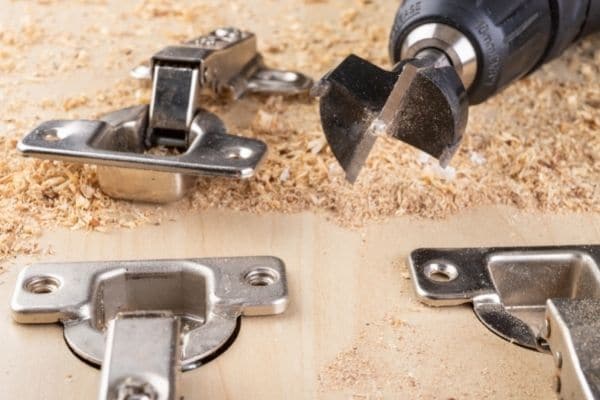
Identifiable by its relatively narrow shank and rounded block cutting head, the Forstner bit is a wood project-specific accessory.
These borers deliver wide, circular boreholes with a flat base — in contrast with the angled bottom of most drill holes. This makes them precision woodworking bits, allowing you to create recesses for dowels, studs, and hinges.
While they can be utilized with any rotational drill — I personally wouldn’t use one in any machine except a pillar press. Without using one of these tools in a perpendicular drill, you will end up with a less than precise or level hole — defeating the object of these accuracy-centric bits.
- Used for fine woodworking and cabinet jobs.
- Flat borehole base.
- Should be used with a pillar press.
6. Countersinking Bit
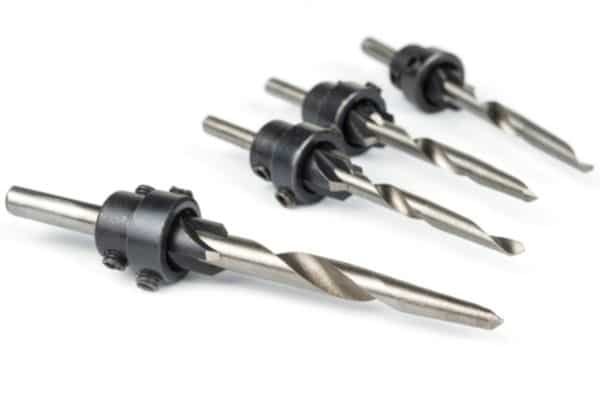
Another job-specific woodworking bit. As the name suggests, countersink bits create a narrow borehole combined with a wider aperture at the material surface.
This allows skilled artisans and cabinet makers to recess screws or bolts so that they’re flush with the timber surface — for a tidy and snag-free finish. Again, they can be used with any rotational machine, although for pure aesthetic accuracy, I would suggest using a pedestal drill.
- Essential for furniture making and fine carpentry.
- Creates a borehole and recess.
- Should be attached to a pillar pedestal drill.
7. Installer Bit
Out of all the drill bit types and uses — the installer bit has to be the most novel.
As suggested by its moniker, this drill accessory is used for installing thin wiring — as used in security alarms, CCTV, and audio-visual entertainment systems.
Available in a range of sizes up to 18 inches, these borers will drive into plaster, wood, and semi-dense masonry. Once the bit has penetrated through the target surface and emerged on the opposite side — you pass a wire through a small ‘eye’ on the bit tip, then slowly withdraw the bit to pull the cable through.
This allows you to pass awkward electrical wiring through the smallest of gaps for a clean finish.
- A crucial tool for electricians, security system installers, and entertainment specialists.
- Available in medium to long bit sizes.
- Multi-medium compatible.
8. Step Drill Bit

Focusing on boring into sheet metals — up to 0.25 inches in depth — these bits boast a stepped-pyramid design. This allows you to gradually increase the size of the hole as the boring head penetrates — not only reducing the risk of slicing and base material damage but also permitting you to drill various sized holes with a single tip.
These accessories usually include a substantial groove to remove metal burrs and shards, and often have an imprinted index on the bit detailing each step’s drilling width.
- The best type of drill bit for metal sheeting.
- Requires a drill with relatively high torque.
- Negates the requirements for numerous metal bits.
9. Tile Bit
Drilling into tiles can be one of the most challenging projects for the home DIYer or trade professional. Hence why I created the ultimate How to Drill Into Tile 101.
Carbide-tipped, these cutting heads reduce the risks of chipping, cracking, and breaking ceramic and porcelain tiles when boring a hole. Crucial for kitchen and bathroom work — for example, when hanging showerheads or installing soap dispensers — they can theoretically be used with any rotational drill.
However, just because you have a tile-specific accessory doesn’t mean you can be reckless. I recommend using a drill/driver with a variable speed range that has the capacity to drill at a low 400-600 rpm.
- Ideal for porcelain and ceramic tiles.
- Reduces the likelihood of chips and cracks.
- Essential for electricians, kitchen and bathroom installers, and plumbers.
10. Masonry Bit

The consummate beasts of brawn, masonry drill bits are unquestionably the ultimate drill bit types for concrete.
Usually carbide-tipped — unless you purchase them from a dollar store — these mighty monsters plow into cement, bonded hardcore, render, and brickwork. Robust and durable, they can be utilized with standard rotational machines and hammer drills.
For the extreme address of the densest of concrete, you will need an SDS masonry head combined with a rotary drill.
- The strongest type of drill bit.
- Used for boring into concrete and brickwork.
- Ideally used with hammer or rotary drills.
- The pinnacle of all hammer drill bit types.
11. Core Bits
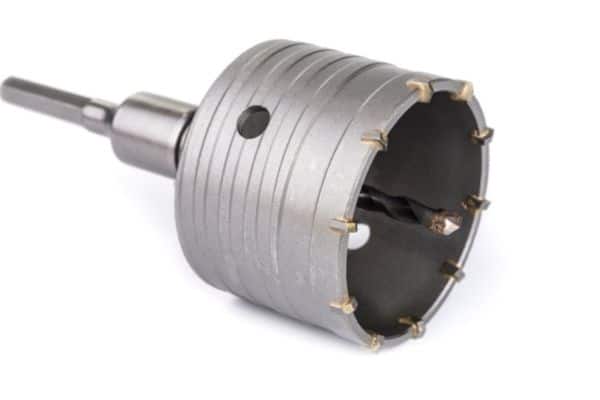
Possibly, the easiest of all drill bit shapes to identify.
The core bit looks like a rounded cup attached to a thin shank. With a hollow center, it cuts only the exterior of a hole, leaving the center intact. When complete, the cutting material is removed in one piece.
These bits are used for creating substantial holes in masonry and brickwork — providing a space sufficiently large for sewage and drainpipes, air-conditioning ducts, and extractor fan flues.
However, due to the challenges of addressing a seriously dense material and making a large hole — you need a beast of a drill. In no uncertain terms, only a rotary drill has the capacity and grunt to use these bits.
- Heavy-duty masonry boring.
- Requires a rotary drill.
- Available in a variety of diameters.
12. Hole Saw Bit
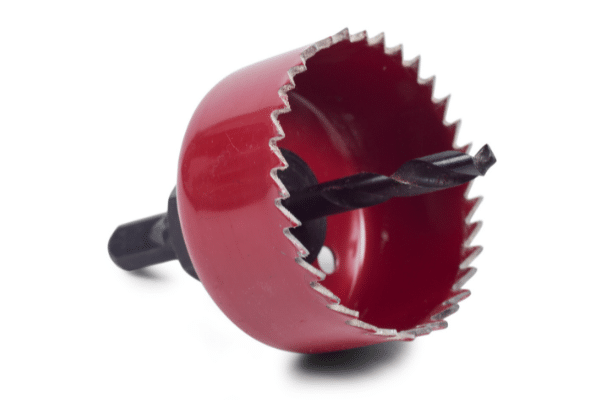
Featuring a similar cup head yet with more pronounced tenon saw-like teeth, it’s most typically utilized for creating wire and pipe channels.
- Compatible with all rotational drills.
- Can address ply, MDF, and raw timber.
- Variety of diameter sizes.
13. Screwdriver Bits
From all the different types of drill bits and their uses, screwdriver heads are, in truth, a category of their own.
They include a variety of formats, such as:
- Hex — common for furniture building, especially flatpack, utilized instead of an Allen key.
- Torx — star-shaped, typical to vehicle construction and electronic product casings.
- Slots and Phillips — the most common screw types.
These formats allow you to use your drill as an electric screwdriver — permitting you to drive into timbers much more rapidly than you could by hand, and enables the penetration of seriously dense hardwoods.
However, without high torque, compatible chuck head, and extensive variable speeds — they’re pointless. Hence, the tool you need is a cordless drill/driver.
- Crucial for the DIYer and trade contractor.
- Requires a drill-driver.
- Some drills may require an adapter/extension for the hex shank.
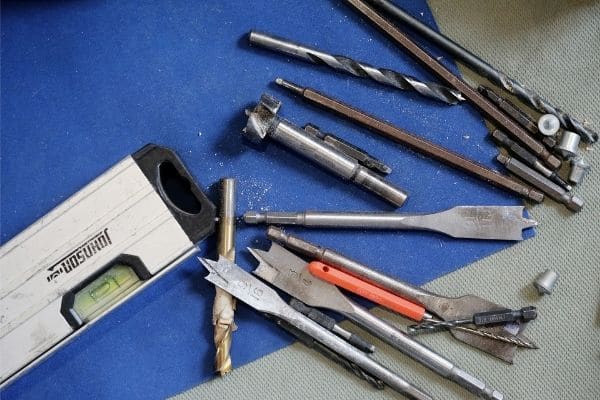
Masonry, Wood and Metal Drill Bits Maintenance
As a responsible DIYer or trade-pro, you know that looking after your equipment is crucial — and this responsibility extends to drill bits.
Let’s face it, these boring tools take a serious amount of abuse — they drive, shear, pound, and hammer for extended periods of time, are exposed to sharp and degrading materials, and have to endure extremely high friction-generated heat.
If you fail to look after your bits, they will become blunt and fragile. Not only does this mean you may be unable to complete your project, but also can result in a damaged drill, target material, or even cause you injury.
Here are my tips for keeping your drill bits in perfect operation:
- Sharpen regularly — you can use a grinder or sharpening tool.
- Store safely — your drill bits come in case or sheath to protect them, so use it!
- Use the correct bit for the material in hand.
- Check that the bit is compatible with your drill type and chuck size/style.
- Clean the bit after every use.
- Oil regularly to prevent corrosion.
- Regularly inspect drill bits for damage or degradation.
- Keep your drill bits in a cool and dry location.
- Don’t overwork the bit — use high speeds for soft materials and low speeds for dense mediums.
- Allow the bit to cool naturally after use — don’t dip into water or ice.
- Use a cutting fluid on stubborn materials.
- Always address the bit at 90-degrees to the base medium.
Conclusion
Ensuring you have the correct drill bit for your current project will ensure effortless use, safe operation, and rewarding results.
In addition to choosing the correct format, always check that your chosen boring head is suitable for your drill type, possesses the correct diameter for your job, and is compatible with the chuck. Use the above information as a guide, and you’ll be drilling like a pro!
I hope that you enjoyed this article and found the information helpful. And, if you have a buddy who you believe may benefit from this Types of Drill Bits 101 — please feel free to share!
Formats and Kinds of Drill Bits FAQs
Q: What Drill Bit for Metal?
One of the most commonly asked questions by newbie drill users is — which drill bits are for metal? In my opinion, the best drill bit types for metal are the durable and heat-resistant HSS borers and titanium-tipped bits.
Q: What Type of Drill Bit for Steel?
Consult any respectable types of drill bits chart, and you’ll see that the optimum boring heads for steel are HSS and titanium-capped bits.
Q: What Are the Step Drill Bit Uses?
Step bits allow you to create a multitude of hole diameters with a single drill bit.
Q: What Drill Bit for Concrete?
When addressing dense brickwork and cement, you need a hardcore boring head. Ensure that you utilize a masonry bit in combination with a hammer or rotary drill.
Q: Which Drill Bit for Wood?
When addressing timber, use a brad-point bit. This cutting head features a pointed tip for accuracy and twin spurs that rotate around the central axis to create a clean hole.
Q: Which Drill Bit to Use for Wood That’s Thick?
To create large diameter holes in thick timbers — for example, when creating wire channeling — use an auger bit.
Q: Which Drill Bit for Tile?
Tile is notoriously fragile — hence you need a tip that will not crack, chip, and break the material. For ceramic and porcelain tiles, use a carbide-tipped bit. On decorative glass tiles, utilize a diamond-tipped boring head.










